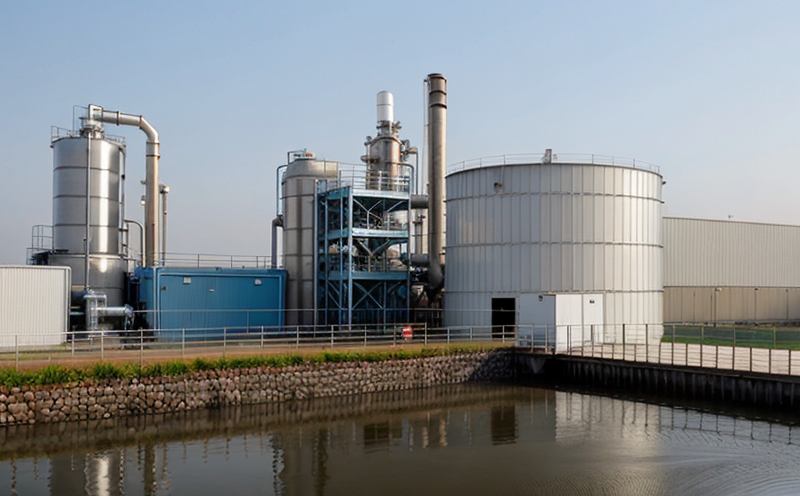JIS K0102 Industrial Wastewater Testing Methods
The Japanese Industrial Standard (JIS) K0102 specifies methods for testing industrial wastewater. This standard is crucial in ensuring the quality and safety of water used or discharged by manufacturing facilities, particularly those involved in processes that generate significant amounts of wastewater.
Industrial sectors such as textile production, electronics manufacturing, and chemical processing often produce wastewater containing a variety of contaminants including heavy metals, organic compounds, and other pollutants. The JIS K0102 provides precise protocols for quantifying these substances to ensure compliance with environmental regulations and internal quality standards. Compliance is essential not only for avoiding fines but also for maintaining the reputation of the company as an environmentally responsible entity.
The standard covers a range of tests including pH measurement, turbidity determination, biological oxygen demand (BOD), chemical oxygen demand (COD), total suspended solids (TSS), and heavy metal analysis. Each test is designed to provide actionable data that helps in optimizing processes and reducing environmental impact. For instance, accurate COD measurements can indicate the efficiency of wastewater treatment systems.
Compliance with JIS K0102 requires not only precise testing but also robust quality assurance practices. Laboratories specializing in this service must possess state-of-the-art equipment, skilled personnel, and rigorous procedures to ensure reliable results. The testing process typically involves collecting samples at specific intervals throughout the production cycle, transporting them under controlled conditions, and then subjecting them to a series of analytical techniques.
One significant aspect is the use of biological oxygen demand (BOD) tests which measure the amount of dissolved oxygen consumed by microorganisms in water. This helps assess the organic load present in wastewater, providing insights into potential pollution levels. Similarly, chemical oxygen demand (COD) testing offers a quick estimate of total oxidizable organic content but does not differentiate between biodegradable and non-biodegradable compounds.
The JIS K0102 also emphasizes the importance of heavy metal analysis, particularly for metals like lead, mercury, cadmium, and chromium. These elements can have severe consequences if present in excess quantities in water bodies or soil. Proper testing ensures that industrial discharges do not exceed allowable limits set by environmental protection authorities.
In summary, the JIS K0102 Industrial Wastewater Testing Methods play a vital role in safeguarding both natural resources and public health. By adhering to this standard, industries can contribute significantly to sustainable development goals while meeting regulatory requirements effectively.
Applied Standards
The JIS K0102 Industrial Wastewater Testing Methods are closely aligned with international standards such as ISO 14031 and ASTM D7892. These standards provide a framework for environmental management systems and wastewater analysis, respectively. Compliance with these guidelines ensures that the testing methods employed meet stringent quality criteria.
ISO 14031 focuses on environmental performance indicators, which are key metrics used to evaluate an organization's impact on the environment. This includes tracking resource use, waste generation, and emissions. By aligning itself with ISO 14031, a laboratory following JIS K0102 can demonstrate its commitment to continuous improvement in sustainability practices.
ASTM D7892 addresses specific aspects of wastewater analysis, particularly the determination of total organic carbon (TOC) and related parameters. While it differs slightly from COD tests mentioned earlier, it complements JIS K0102 by offering additional insights into water quality through different analytical approaches.
Together, these standards form a comprehensive set of guidelines that support rigorous testing procedures underpinning the reliability of results generated by laboratories adhering to JIS K0102. This alignment enhances credibility and trustworthiness among clients seeking accurate data about their industrial wastewater streams.
Scope and Methodology
| Test Parameter | Description | Methodology |
|---|---|---|
| pH Measurement | Determines acidity or basicity of wastewater. | Use pH meter calibrated according to manufacturer's instructions; conduct multiple readings and average them. |
| Turbidity Determination | Evaluates clarity by measuring suspended particles. | Use a turbidimeter, compare sample against reference solutions of known turbidity levels. |
| Biological Oxygen Demand (BOD) | Metric for organic matter content based on oxygen consumption during microbial decomposition. | Cultivate samples in incubators at specified temperatures over five-day intervals; measure dissolved oxygen changes. |
| Chemical Oxygen Demand (COD) | Estimate total oxidizable substances using potassium dichromate solution. | Boil sample with reagents, cool, then titrate against standard silver nitrate. |
| Total Suspended Solids (TSS) | Measure solid matter not dissolved in water. | Filtration through specified pore size filters followed by drying and weighing. |
| Heavy Metal Analysis | Detect specific heavy metals like lead, mercury, cadmium, chromium. | Inductively coupled plasma mass spectrometry (ICP-MS) or atomic absorption spectroscopy (AAS). |
The methodologies outlined above are integral parts of the JIS K0102 framework. Each step is meticulously documented to ensure transparency and repeatability, allowing for consistent results across different analyses.
Environmental and Sustainability Contributions
- Pollution Prevention: Identifying contaminants early allows industries to implement corrective measures promptly.
- Emission Reduction: Monitoring BOD, COD, and TSS helps in optimizing treatment processes reducing discharge volumes.
- Resource Conservation: Understanding the efficiency of water usage within industrial operations promotes conservation efforts.
- Biodiversity Protection: By ensuring safe wastewater discharge into ecosystems, biodiversity is preserved downstream.
The application of JIS K0102 supports broader sustainability goals by fostering responsible resource management. Through comprehensive monitoring and proactive intervention strategies, companies can minimize their ecological footprint significantly.





